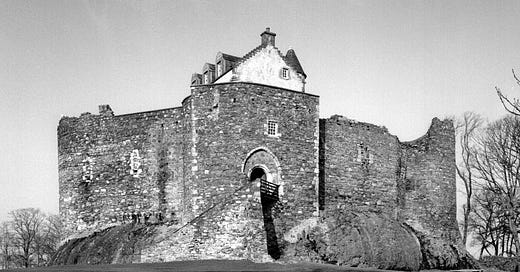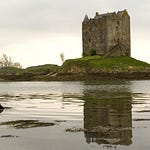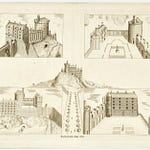Welcome back to "A Scottish Castle, A Day," brought to you by bagtownclans.com. I’m your host, Colin MacDonald, and today we’re heading to the rugged coastline of western Scotland to explore Dunstaffnage Castle. This formidable stronghold, perched on a rocky promontory at the entrance to Loch Etive, has witnessed centuries of Scottish history—from the fierce clashes between the MacDougalls and Robert the Bruce to its role in the Jacobite risings.
Dunstaffnage Castle, known in Scottish Gaelic as Caisteal Dhùn Stadhainis, is one of the oldest stone castles in Scotland. Built in the 13th century, it’s part of a local group of ancient castles that includes Castle Sween and Castle Tioram. Dunstaffnage stands guard over a highly strategic location—protecting the seaward approaches from the Firth of Lorn to the interior of Scotland through the Pass of Brander. This massive fortress continues to awe visitors, its sturdy walls a reminder of a time when control over land and sea was fiercely contested.
Before the stone walls of Dunstaffnage rose from this dramatic landscape, there may have been an ancient Dál Riatan stronghold here, dating as far back as the 7th century. Legend even claims that the famous Stone of Destiny was housed at Dunstaffnage before it was moved to Scone Palace in 843. However, some historians suggest more likely candidates for this honor are Dunadd or Iona. Regardless, Dunstaffnage’s location along the rugged Argyll coast would have made it a critical site long before the imposing castle we see today was constructed.
The castle as we know it began to take shape in the 13th century under the MacDougall lords of Lorn. The MacDougalls were descendants of Somerled, the powerful Lord of the Isles, and it was likely his grandson, Duncan MacDougall, who built Dunstaffnage. Duncan’s family was deeply rooted in the region—he also founded Ardchattan Priory nearby and sought to solidify his power with this formidable new stronghold. Duncan’s son, Ewen MacDougall, further expanded the family’s influence, even styling himself as “King of the Isles” despite the MacDonalds holding that official title.
Ewen likely added the three round towers to the castle, enhancing its defenses and making a bold statement of the MacDougall's power. By the late 13th century, the castle’s thick walls were already serving a critical role in guarding the surrounding lands and waters from potential invaders.
But this dominance didn’t last forever. As with many powerful Scottish families, the MacDougalls found themselves on the wrong side of history during the Wars of Scottish Independence. They backed John Balliol against Robert the Bruce, a choice that would lead to disaster for their clan. In 1308, Robert the Bruce decisively defeated the MacDougalls at the Battle of the Pass of Brander. After his victory, Bruce laid siege to Dunstaffnage, and the castle fell into his hands. However, unlike other castles he captured, Bruce did not destroy Dunstaffnage. Instead, he saw its strategic potential and appointed a constable to maintain the fortress as a royal stronghold.
Following its capture by Robert the Bruce, Dunstaffnage became a Crown property. Over the centuries, it passed through the hands of various keepers and saw continued use as a royal fortress. James I seized the castle in 1431, and it became a base for royal expeditions during the 15th and 16th centuries, especially against the MacDonalds, the Clan Campbell’s old rivals. The Campbells themselves took control of the castle in the late 15th century, after James III granted it to Colin Campbell, the 1st Earl of Argyll.
Under the Campbells, Dunstaffnage continued to serve as a key military site. During the Civil War, the castle withstood attacks, and it was later burned by royalist forces in 1685 after the failure of the Earl of Argyll’s rebellion against James VII. Yet, through it all, Dunstaffnage stood firm. It even played a part in the Jacobite risings of 1715 and 1745, when government troops garrisoned the fortress.
One of Dunstaffnage’s most famous prisoners arrived in 1746—Flora MacDonald. After aiding Bonnie Prince Charlie’s dramatic escape from the British, Flora was captured and briefly imprisoned in the castle before being sent to the Tower of London. Her time at Dunstaffnage was short, but it adds to the castle’s rich tapestry of historical events.
The architecture of Dunstaffnage is as impressive as its history. The castle’s thick stone curtain walls stand up to 60 feet tall, wrapping around a roughly rectangular courtyard. Originally, only narrow arrow slits broke the surface of the walls, but these were later widened into gunloops as warfare evolved. The three round towers that Ewen MacDougall added are still prominent features today, although the east tower was replaced by a gatehouse in the 15th century, when the Campbells rebuilt much of the structure.
The gatehouse, a four-story tower, was remodeled in the 18th century to serve as a more comfortable residence for the Campbells. While much of the castle has been altered or rebuilt over the years, it still retains the imposing presence it had during its medieval heyday.
And, like many ancient Scottish castles, Dunstaffnage has its ghost. The "Ell-maid of Dunstaffnage," a type of gruagach, is said to haunt the castle, her appearances linked to significant events in the lives of the hereditary keepers, the Captains of Dunstaffnage.
By the 19th century, Dunstaffnage had fallen into decay, and an accidental fire in 1810 rendered the gatehouse uninhabitable. The hereditary captains ceased to live in the castle, moving instead to a nearby residence. Restoration efforts began in the early 20th century, but it wasn’t until 1958 that the castle was handed into the care of the state. Today, Dunstaffnage Castle is maintained by Historic Environment Scotland and remains open to the public. The hereditary Captain of Dunstaffnage still holds the title, although it is now more ceremonial, requiring only that they spend three nights in the castle each year.
Today, Dunstaffnage Castle remains a symbol of Scotland’s turbulent history, a silent sentinel on the Argyll coast. Whether you’re drawn by its dramatic location, its medieval architecture, or the fascinating stories of the people who lived, fought, and died within its walls, Dunstaffnage Castle is a must-see for anyone exploring the rich history of Scotland.
Thank you for joining us on today’s episode of "A Scottish Castle, A Day." We hope you’ve enjoyed this journey through the halls and history of Dunstaffnage Castle. Be sure to tune in tomorrow as we explore another of Scotland’s grand castles. I’m Colin MacDonald, and until next time, Slán go fóill.













Share this post